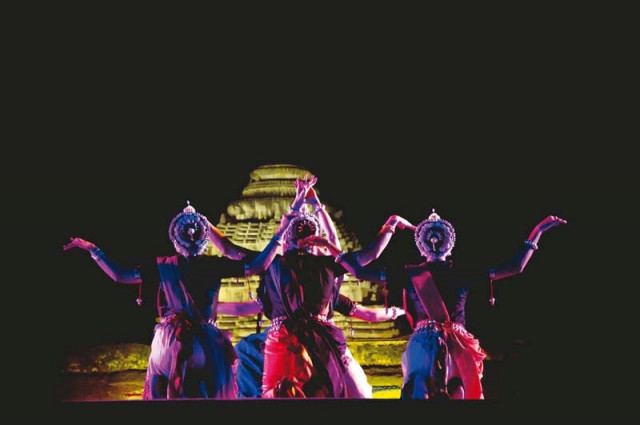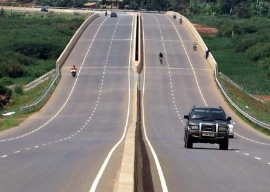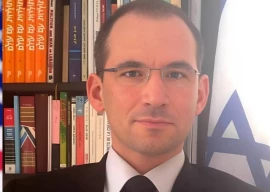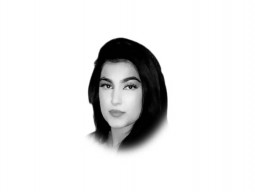
The word kathak is derived from the Sanskrit word for storyteller, kathaka, and is used to represent both the dancer and the dance form. Song, music, dance, mime, acting, and narration are all used in kathak to tell sensitive, elaborate stories that engage the audience.
 Kathak tells sensitive, elaborate stories that engage the audience. PHOTO : ALLY ADNAN
Kathak tells sensitive, elaborate stories that engage the audience. PHOTO : ALLY ADNANThere are two primary aspects of kathak: nritta, the technical aspect, and nritiya, the expressional aspect. Nritta is pure dance that focuses on taal, the rhythmic cycle, and laya, the tempo. The expressional aspect of kathak, the nritiya, focuses on abhinaya or the art of histrionics, and employs the body, sounds, visuals, and emotions.Originally, kathak was deeply rooted in Hinduism, being performed in temples for centuries. Nomadic performers also practiced kathak in the region. The arrival of Muslims from Afghanistan, Iran and Turkey in the 8th Century influenced the culture of the region, and as they continued migrating, Kathak absorbed Muslim elements of music, dance, dress and aesthetics. The fundamentally simple dance started moving from the temples and streets to the courts and palaces of the Rajput, and subsequently the Mughals, in the 11th Century. This introduced greater refinement, elaborate etiquette, complex technique, and elegant dress to kathak. In Muslim courts, the focus of kathak shifted from telling stories about Hindu mythology to technique, skill, rhythmic virtuosity, and speed. The resulting dance was truly secular, neither Hindu nor Muslim, but highly sophisticated, refined and distinct.
Nritta is performed to a specific taal, typically in one of three layas: vilambit (slow), madh (medium), or drut (fast). The first beat of the taal is known as sam. A recurring musical refrain, known as the lehra, is played throughout the dance on the sarangi, harmonium, flute or sitar, and it is accompanied by a percussionist on the tabla or the pakahwaj. One complete cycle, the aavardi, begins and culminates in the sam and encompasses a single complete phrase of the lehra.
 Kathak involves song, music, dance, mime, acting, and narration. PHOTO : ALLY ADNAN
Kathak involves song, music, dance, mime, acting, and narration. PHOTO : ALLY ADNANAfter the introductory elements, the dancer performs composed pieces that consist of bols (mnemonic syllables), which are of five types. These are the alphabets of tabla, pakhawaj and kathak, numbers, and the sargam. A dancer usually recites the composed pieces before their execution. The skillful recitation of bols is known as parhant. Short composed pieces are known as tukras whereas the long ones are called toras. These pieces are played on the tabla while the dancer performs them on stage. There are many types of the composed pieces such as the ginti, natwari, parmalu, saada, and sangeet varieties. Composed pieces that are played on the pakhawaj are known as parans. A tihaii is a rhythmic pattern that is executed three times in succession and is often used to end toras and parans. A kavit is a short poem fixed in a specific taal. The style of walking is known as gat. Tatkar refers to footwork which is performed throughout the recital but at greater length, and with more complexity, towards the end of a performance. A lari is a composition of footwork that ends in a tihaii. A tihaii that is repeated three times is known as chakardar.A large set of items is available to kathaks for the performance of nritta. The performance usually begins with a combination of one or more of four items — vandana, aamad, thaath and salami. Vandana is a prayer offered to one of the deities, aamad is the entry of the dancer on the stage, thaath is the graceful style of standing, and salami refers to the salutation made to the audience in a distinctly Muslim style.
 Kathak is one of the most beautiful representations of the soul of India and Pakistan. PHOTO : ALLY ADNAN
Kathak is one of the most beautiful representations of the soul of India and Pakistan. PHOTO : ALLY ADNANNritiya is usually performed to the musical genres of thumri, dadra, kajri, kafi, bhajan, or ghazal, typically in madh laya. The dancer uses the lyrical, emotional and spiritual content of the song as the foundation of nritiya and communicates with the audience using variations of movements, gestures and expressions. Nritiya requires creativity, imagination and ingenuity in addition to knowledge, expertise and virtuosity. The success of a performance of nritiya depends almost entirely on the dancer’s emotional resourcefulness, interpretive ability and creative brilliance; a command over taal and laya is necessary but far from sufficient to perform nritiya expertly.
A kathak employs four abhinayas, with varying levels of emphasis, in the performance of nritiya. Angika abhinaya refers to the use of the movement of the various parts of the body to narrate a story. The movements of the hands, or hastak, and facial expressions, or mukhaj abhinaya, fall under the category of angika abhinaya. Vachika abhinaya involve the use of speech and song. Ahariya abhinaya employ costumes, jewelry, make-up, stage design, props, and decorative items. Sattvika abhinaya deals with the expression and communication of spiritual, emotional, transcendent, and numinous states.
Nine primary types of ras, emotional essence, are communicated through kathak — compassion, disgust, fury, heroism, horror, laughter, love, peace and wonder. Eight of these were defined by Bharat Mani in the Natya Shastra, an ancient treatise on the performing arts, written between 200 BCE and 200 CE. A ninth rasa — peace — was added later. Each ras has an associated deity and colour.
Gharanas
There are five major gharanas or schools of kathak. These are the Benares, Jaipur, Lahore, Lucknow, and Raigarh gharanas.
The Benaras gharana was established by Pandit Janakiprasad who was a kathak from the village of Mailsur in Bikaner, India. Moving to Benares at a very young age, he made the holy city his home. This school of kathak strongly retains elements of the dance’s Hindu origin and adopts very little of the Muslim influences on it. The dance bols used in this gharana belong purely to kathak and are known as natwari bols. Dancers of the gharana execute chakkars or spins both clockwise and anti-clockwise, strike their heels frequently, employ bhajans — Hindu devotional songs — extensively, and cover greater expanses of the dance floor. The Jaipur gharana is one of the two major schools of kathak. It developed in the courts of Kachwaha rulers of Jaipur in Rajasthan who supported kathak and other performing arts with great enthusiasm and developed the school under their patronage. The gharana is known for complex tatkaar, intricate compositions, technical brilliance, and great rhythmic virtuosity. Dancers of the gharana use the pakhawaj more than the tabla since they prefer to perform long and complicated parans.
 The simple art of storytelling developed into a mature dance by the 10th Century AD. PHOTO : ALLY ADNAN
The simple art of storytelling developed into a mature dance by the 10th Century AD. PHOTO : ALLY ADNANThe Lahore gharana is an offshoot of the Lucknow gharana and was founded by Maharaj Ghulam Hussain Kathak who was a student of Achhan Maharaj of the Lucknow gharana. Maharaj moved to Pakistan after Partition and developed a more stylised form of kathak that focused primarily on aesthetic beauty, sophistication and poise. Developed in virtual isolation from the global world of kathak, this form came to be known as the Lahore gharana. The students of Maharaj Ghulam Hussain Kathak continue to represent this gharana.The Lucknow gharana developed during the reigns of Nawab Asif Ud Daula and Nawab Wajid Ali Shah in Oudh. The foundation of the gharana was laid by Ishwari Prasajdi, who hailed from the village of Handiya in Allahabad. His grandson, Prakashji, became the court dancer for Nawab Asif Ud Daula and his son Thakur Prasad Maharaj was the teacher of Nawab Wajid Ali Shah and the principal dancer in his court. Thakur Prasad Maharaj is said to be the true founder of the gharana. Dancers of the gharana are known for grace, elegance and poise and for placing an equal emphasis on nritiya and nritta. A direct descendant of Ishwari Prasadji, Birju Maharaj is the chief representative of the gharana and considered by many to be the greatest kathak alive today.
The confluence and convergence of different styles, ideas, theories, and philosophies resulted in the formation of the Raigarh gharana. It was founded by Maharaja Chakardhar Singh in the princely state of Raigarh in the beginning of the 20th Century. The prince was a patron of the arts, a skilled tabla player, a scholar of kathak and the author of more than 15 books on music and dance. He would invite a large number of percussionists and dancers to his court so that they could learn from each other and work to advance the art of kathak. The luminaries of this gharana included Pandits Jagannath Prasad and Jailal of the Jaipur gharana and Kalka Prasadji, Achhan Maharaj, Lachhan Maharaj and Shambhu Maharaj of the Lucknow gharana.
Male kathaks traditionally dance wearing just a dhoti — a rectangular piece of cloth tied around the waist — and no shirt. Muslim influence added two costumes, the angrakha and the simple kurta worn with a pajama. Female kathaks traditionally performed in saris but Muslim influence added more options like the lehnga and choli worn with a dupatta. A lehnga made of sheer cloth, worn with a churidaar pajama is the most appropriate costume for female kathaks because it allows viewers to see the dancer’s legs through the translucency. It also flares in a dramatic fashion during the chakkars which are an integral part of kathak.
Over a period of more than 35 centuries, kathak has continued to grow in form, content, technique, and repertoire and has become an increasingly secular art form. Twenty-first Century kathak incorporates elements of the opulent splendor of Mughal courts, the ethos of Hindu temples, and the aesthetics of Persian art forms, along with the literature, poetry, music, and dance of not just the Subcontinent but the entire world. It is one of the most beautiful representations of the soul of India and Pakistan.
Ally Adnan is a visiting professor at the Department of Musicology at Punjab University. He tweets @allyadnan
Published in The Express Tribune, Sunday Magazine, November 8th, 2015.


















COMMENTS
Comments are moderated and generally will be posted if they are on-topic and not abusive.
For more information, please see our Comments FAQ